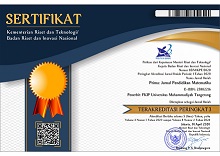STEM IN ACTION: REAL-WORLD APPLICATIONS OF SCIENCE, TECHNOLOGY, ENGINEERING, AND MATH
Abstract
Keywords
Full Text:
PDFReferences
Ang, I. J. X., & Lim, K. H. (2019, June). Enhancing STEM education using augmented reality and machine learning. In 2019 7th International Conference on Smart Computing & Communications (ICSCC) (pp. 1-5). IEEE. https://doi.org/10.1109/ICSCC.2019.8843619
Banks, C. M., & Sokolowski, J. A. (2010, April). Meeting the challenges of STEM education: teaching modeling and simulation with real-world applications. In Proceedings of the 2010 Spring Simulation Multiconference (pp. 1-6). https://doi.org/10.1145/1878537.1878598
Bryan, L., & Guzey, S. S. (2020). K-12 STEM education: An overview of perspectives and considerations. Hellenic Journal of STEM Education, 1(1), 5-15. https://doi.org/10.51724/hjstemed.v1i1.5
Bybee, R. W., & Landes, N. M. (2019). STEM education research: Engaged learning in science, technology, engineering, and mathematics. International Journal of STEM Education, 6(1), 21. https://doi.org/10.1186/s40594-019-0173-y
Chrysafiadi, K., & Virvou, M. (2019). AI technologies for personalized learning: A systematic literature review. Journal of Educational Technology & Society, 22(3), 154-170. https://www.jstor.org/stable/jeductechsoci.22.3.154
Dare, E. A., Keratithamkul, K., Hiwatig, B. M., & Li, F. (2021). Beyond content: The role of STEM disciplines, real-world problems, 21st century skills, and STEM careers within science teachers’ conceptions of integrated STEM education. Education Sciences, 11(11), 737. https://doi.org/10.3390/educsci11110737
Dobrin, J. (2020). Learning for the Real World: Interdisciplinary Challenge Projects to Facilitate Real-World Learning in STEM. In: Akerson, V.L., Buck, G.A. (eds) Critical Questions in STEM Education. Contemporary Trends and Issues in Science Education, vol 51. Springer, Cham. https://doi.org/10.1007/978-3-030-57646-2_8
Gadanidis, G., & Borba, M. (2020). AI in mathematics education: An overview. International Journal of Science and Mathematics Education, 18(8), 1425-1443. https://doi.org/10.1007/s10763-020-10139-0
Kay, R. H., & Greenhill, V. (2020). Robotics, artificial intelligence, and the internet of things in education: A systematic review. Educational Technology Research and Development, 68(3), 1501–1540. https://doi.org/10.1007/s11423-019-09718-7
Kolmos, A., Holgaard, J. E., & Clausen, M. B. (2019). Framework for authentic problem-based learning in engineering. European Journal of Engineering Education, 44(1-2), 67-83. https://doi.org/10.1080/03043797.2018.1451632
Panch, T., Mattie, H., & Celi, L. A. (2019). The "inconvenient truth" about AI in healthcare. npj Digital Medicine, 2(1), 77. https://doi.org/10.1038/s41746-019-0155-4
Pease, R., Vuke, M., June Maker, C., & Muammar, O. M. (2020). A practical guide for implementing the STEM assessment results in classrooms: Using strength-based reports and real engagement in active problem solving. Journal of Advanced Academics, 31(3), 367-406. https://doi.org/10.1177/1932202X20911643
Prajoko, S., Sukmawati, I., Maris, A. F., & Wulanjani, A. N. (2023). Project based learning (pjbl) model with stem approach on students’ conceptual understanding and creativity. Jurnal Pendidikan IPA Indonesia, 12(3). https://doi.org/10.15294/jpii.v12i3.42973
Prince, M. (2020). The impact of project-based learning on student motivation in a high school STEM classroom. Journal of Science Education and Technology, 29(1), 66–78. https://doi.org/10.1007/s10956-019-09807-6
Raghupathi, W., & Raghupathi, V. (2019). Big data analytics in healthcare: Promise and potential. Health Information Science and Systems, 7(1), 3. https://doi.org/10.1007/s13755-019-0076-6
Rahman, N. A., Rosli, R., Rambely, A. S., Siregar, N. C., Capraro, M. M., & Capraro, R. M. (2022). Secondary school teachers’ perceptions of STEM pedagogical content knowledge. Journal on Mathematics Education, 13(1), 119–134. https://doi.org/10.22342/jme.v13i1.pp119-134
Rosli, R., & Siregar, N. C. (2022). Teacher professional development on science, technology, engineering, and mathematics: A bibliometric analysis. Contemporary Educational Research Journal, 12(1), 01–17. https://doi.org/10.18844/cerj.v12i1.5417
Rosli, R., Abdullah, M., Siregar, N. C., Abdul Hamid, N. S., Abdullah, S., Beng, G. K., Halim, L., Mat Daud, N., Bahari, S. A., Abd Majid, R., & Bais, B. (2020). Student awareness of space science: Rasch model analysis for validity and reliability. World Journal of Education, 10(3), 170-177. https://files.eric.ed.gov/fulltext/EJ1265412.pdf
Rosli, R., Abdullah, M., Siregar, N. C., Hamid, N. S. A., Abdullah, S., Beng, G. K., ... & Bais, B. (2019, July). Exploring space science through the UKM-SIDπ Outreach Program. In 2019 6th International Conference on Space Science and Communication (IconSpace) (pp. 253-256). IEEE. https://doi.org/10.1109/IconSpace.2019.8905957
Sadler, T. D. (2019). Situated learning in science education: Socio-scientific issues as contexts for practice. Studies in Science Education, 55(1), 83-107. https://doi.org/10.1080/03057267.2019.1573192
Siregar, N. C. (2020). Interest STEM based on family background for secondary school students: Validity and reliability instrument using Rasch model analysis. Proceeding in RSU International Research Conference, May 1, 2020. Pathum Thani, Thailand. https://doi.org/10.14458/RSU.res.2020.131
Siregar, N. C., & Anggrayni, D. (2023). STEM-based facilitator in weather observation to determine prayer time. Aksioma, 12(1), 10-17. https://jurnal.fkip.untad.ac.id/index.php/jax/article/view/3452
Siregar, N. C., & Anggrayni, D. (2023). STEM-based social interaction model in building communication residents of social institutions in Bogor region. Aksioma, 12(1), 37-45. https://jurnal.fkip.untad.ac.id/index.php/jax/article/view/3455
Siregar, N. C., & Nasiah, S. (2022). Mathematics teachers’ professional development: A bibliometric analysis. Aksioma, 11(2), 172-180. https://jurnal.fkip.untad.ac.id/index.php/jax
Siregar, N. C., & Rosli, R. (2021). The effect of STEM interest based on family background for secondary students. Journal of Physics: Conference Series, 1806 (1), 012217. https://iopscience.iop.org/article/10.1088/1742-6596/1806/1/012217/pdf
Siregar, N. C., Rosli, R., & Nite, S. (2023). Students’ interest in Science, Technology, Engineering, and Mathematics (STEM) based on parental education and gender factors. International Electronic Journal of Mathematics Education, 18(2), em0736. https://doi.org/10.29333/iejme/13060
Siregar, N. C., Rosli, R., Maat, S. M., & Capraro, M. M. (2019). The effect of science, technology, engineering, and mathematics (STEM) program on students’ achievement in mathematics: A meta-analysis. International Electronic Journal of Mathematics Education, 15(1), 1-12. https://doi.org/10.29333/iejme/5885
Topol, E. J. (2019). High-performance medicine: The convergence of human and artificial intelligence. Nature Medicine, 25(1), 44–56. https://doi.org/10.1038/s41591-018-0300-7
Weston, M. E., & Bain, A. (2019). The impact of problem-based learning on student learning outcomes for mathematics, reading, science, and social studies: A meta-analysis. Interdisciplinary Journal of Problem-Based Learning, 13(2), Article 8. https://doi.org/10.7771/1541-5015.1811
Zeegers, Y. P., de Jong, O., & Van Merriënboer, J. J. G. (2021). Impact of STEM education: A systematic review on students' learning, motivation, and attitudes. International Journal of STEM Education, 8(1), Article 34. https://doi.org/10.1186/s40594-021-00295-5
DOI: http://dx.doi.org/10.31000/prima.v8i2.11323
Article Metrics
Abstract - 5108 PDF - 1931Refbacks
- There are currently no refbacks.
Prima: Jurnal Pendidikan Matematika
Program Studi Pendidikan Matematika
Fakultas Keguruan dan Ilmu Pendidikan
Universitas Muhammadiyah Tangerang
Jl. Perintis Kemerdekaan I/33, Cikokol
Kota Tangerang, Indonesia
e-mail: primajpm@gmail.com
Prima: Jurnal Pendidikan Matematika (p-ISSN: 2579-9827 | e-ISSN: 2580-2216) is licensed under a Creative Commons Attribution 4.0 International License.







